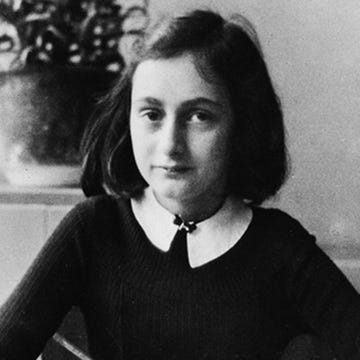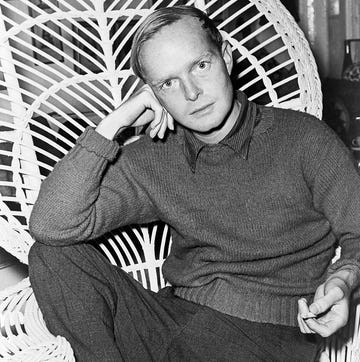Author Roald Dahl's oldest child, daughter Olivia, contracted measles when she was seven years old. Her illness resulted in a rare but serious complication: measles encephalitis, an inflammation of the brain. Olivia died on November 17, 1962, just days after she became ill. Dahl was devastated by the loss of his daughter, but he also used Olivia's death to encourage other parents to vaccinate their children.
After a terrible accident, Dahl and his family moved to England
By 1960, Dahl and his wife, American actress Patricia Neal, had three children: daughters Olivia and Tessa, and son, Theo. On December 5, 1960, tragedy struck the young family when Theo's baby carriage was hit by a taxi in New York City. Sent flying through the air, the 4-month-old's skull was shattered when he landed.
Theo's prognosis was initially dire. However, he began to recover from the accident, though he would require multiple surgeries to relieve fluid build-ups around his brain. In 1961, as Theo's condition stabilized, Dahl and Neal decided to leave New York and make their home in the English village of Great Missenden.
Dahl was able to write in a hut on the property (he was working on Charlie and the Chocolate Factory). He also devised ways to entertain the children, such as when he spelled his daughters' names on the lawn with weedkiller, telling them it had been done by fairies. He shared a particularly close bond with Olivia, who enjoyed making up stories like her father.
In 1962 Olivia Dahl became very ill with measles
In November 1962, the Dahls learned there had been a measles outbreak at seven-year-old Olivia's school. No measles vaccine was available at the time, so those exposed were likely to catch the easily transmissible virus. However, there was an available treatment: gamma globulin, a blood plasma protein whose antibodies could prevent or lessen the severity of the infection.
In America, gamma globulin was regularly administered to children, but in the United Kingdom, it was usually only given to pregnant women. Dahl's brother-in-law, Ashley Miles, was a prominent U.K. doctor, so Neal reached out to him to try to obtain gamma globulin for the children. However, Miles only provided enough for Theo, who was still recovering from his accident, saying, "Let the girls get measles, it will be good for them."
Olivia soon developed the well-known measles rash. After three days she was well enough to get chess lessons from Dahl, and even beat her father at the game. But on the fourth day of her illness, she was lethargic. When Dahl tried to entertain her, he "noticed that her fingers and her mind were not working together and she couldn’t do anything." Later that day Olivia began having convulsions.
Olivia's death devastated Dahl
Olivia was rushed to the hospital, where she was found to have developed measles encephalitis, an inflammation of the brain. Treatment couldn't save the comatose girl, who died on November 17, 1962. Years later, after Dahl's own death, his family discovered a notebook in which he'd described seeing his daughter's body in the hospital: "I went into her room. Sheet was over her. Doctor said to nurse go out. Leave him alone. I kissed her. She was warm. I went out. 'She is warm.' I said to doctors in hall, 'why is she so warm?'"
In life, Dahl's preference had always been to find a way to act in the face of adversity. Following his son's accident, Dahl had helped create a valve to treat Theo's hydrocephalus (Theo recovered before the valve was ready but thousands of other patients benefited from it). But now there was nothing he could do. Shortly after losing Olivia, Dahl told a friend, "I wish we’d had a chance to fight for her."
Neal would later tell People magazine that after losing their daughter, "Roald really almost went crazy." The knowledge that gamma globulin could have prevented the encephalitis that killed his daughter weighed on his mind. Given Theo's accident, he wondered if his family was cursed. Religion provided no solace, as a church leader told him there would be no dogs in the afterlife, which Dahl knew Olivia would hate.
Dahl moved on but never forgot his daughter
At first, Dahl was unable to write after losing Olivia. Instead, he focused on building an elaborate garden, with hundreds of plants from around the globe, to surround Olivia's grave. He also drank more and increased the number of barbiturates he was taking (they had been prescribed for his back pain). But in time he managed to return to work and complete Charlie and the Chocolate Factory (1964). The BFG, written in 1982, was dedicated to Olivia. Dahl kept a picture of Olivia on the wall of his writing hut for the rest of his life.
Questions about his daughter's death always haunted Dahl. Olivia had received a smallpox vaccination but never demonstrated an immune system response afterward. Dahl wondered if an abnormal reaction to this vaccine had played a part in her later developing encephalitis. He spent years writing to doctors about this possibility and even considered setting up a study to evaluate his theory.
Despite deaths like Olivia's, Dahl knew many people continued to consider measles as relatively harmless. In 1986, he wrote "Measles: A Dangerous Illness," a public letter urging people to vaccinate their children: "In my opinion parents who now refuse to have their children immunised are putting the lives of those children at risk." He also noted, "I should think there would be more chance of your child choking to death on a chocolate bar than of becoming seriously ill from a measles immunisation." The letter ended with thoughts of Olivia: "I know how happy she would be if only she could know that her death had helped to save a good deal of illness and death among other children."













